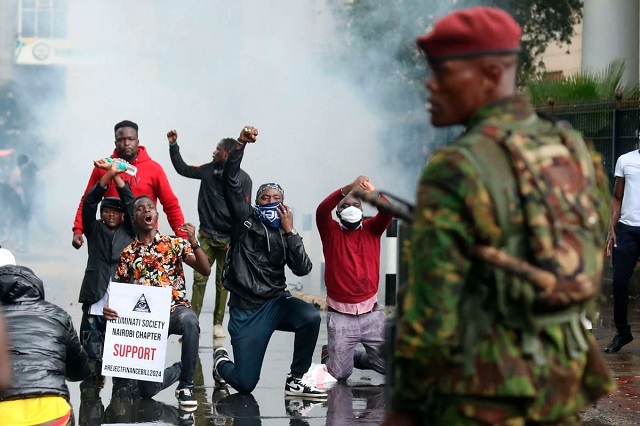
This is what too many are missing as the world scrambles for explanations
COMMENT | NANJALA NYABOLA | There is as yet no resolution after an unprecedented week in Kenyan politics. What began as protests against a rushed-through Finance Bill has revealed a crisis of legitimacy within the executive, the legislature and the police that were sent to do the government’s bidding. And while the protesters have been very clear about their demands – reject the Finance Bill – outsiders who are accustomed to simplistic narratives about African politics have been scrambling and failing to understand what these events really mean.
Kenya is experiencing a polycrisis of sorts. The Finance Bill is the immediate trigger: an annually produced document that lays out the government’s fiscal strategy, and which normally passes without much comment. But this year it attracted an unprecedented level of attention because it contained several proposals for the taxation of everyday goods, including bread, sanitary towels and more. Kenyans were already struggling with the effects of a collapsing currency and the aftermath of the Covid-19 crisis. However, the government was not merely looking to meet its financial obligations but to increase year-on-year spending from the last finance bill, which had already introduced a number of new taxes.
The challenge facing Kenya’s treasury is that the previous administration, of which the current president William Ruto was a part, went on a decade-long borrowing and spending spree, incurring massive debts for ill-advised infrastructure projects that were over budget, poorly executed and behind schedule. For example, rather than renovate the existing railway line that connects the coastal city of Mombasa to the Ugandan capital, it borrowed a great deal of money from China to build a new railway line that only runs across half the country, and which cargo companies have been reluctant to use.
A similar story can be told of the new overpass in Nairobi for which hundreds of trees across what was once Africa’s greenest capital were cut down. The road was built but the tolls were too expensive, so it remains underutilised. Yet the nation remains on the hook for the debt. In 2013, when Uhuru Kenyatta and Ruto came into office, Kenya’s debt-to-GDP ratio was 43%. In 2019 it was 61.7%, and so far in 2024 it is running above 70%.
All this would be bad enough even if Ruto was not also spending a fortune on an unprecedented expansion in the executive. Although Kenya has ministers and cabinet secretaries, the administration attempted to create 50 positions known as chief administrative secretaries distributed across the various ministries, as well as an office of the prime cabinet secretary. Not only is this an expensive duplication of roles, it is also illegal, and a court ruling has held that the positions are unconstitutional – leading to Ruto delaying some of the chief administrative secretary positions.
In addition, the offices of the first lady, the deputy first lady, and the spouse of the prime secretary – each with a budget, an office and staff – were created to great public fanfare. Many elected legislators in the country routinely flaunt their wealth on social media, sharing videos on TikTok of expensive cars and homes, or giving obscenely large donations to religious organisations and charities. Kenyan legislators are the second-highest paid in the world relative to GDP, and would be exempt from many of the new taxes because of their status. The finance bill was described as austerity, but this is not austerity: this is a cash grab from the poor to sustain the lifestyles of the rich.
Moreover, it has emerged that these finance bill measures were not suggested by Kenyans, but were demanded by the International Monetary Fund (IMF) in return for a financing programme. The fact that the measures have destabilised the country should not surprise anyone – IMF measures consistently result in these outcomes in the global majority because they are prepared by people with little to no understanding of the social and political context, and under the pretext that economics is a rational science instead of highly qualified guesswork. Indeed, in its own risk assessment of the implementation of the measures, the organisation foresaw that there would be protests but urged the government to ignore them and pass the measures anyway.
Despite Ruto’s political history, which includes an indictment for crimes against humanity at the international criminal court, outside Kenya there has been a great effort to sanitise him. The U.S. President, Joe Biden, met Ruto days before the finance bill was tabled in the national assembly, and has declared Kenya a key strategic partner of the US. Kenyan police were last week deployed to Haiti on a US-backed mission; Kenya is a frontline state in the US “war on terror”, a base from which drone attacks on al-Shabaab in Somalia are launched; and Kenyan soldiers have been in Somalia for more than a decade. A stable Kenya is crucial to western geopolitics, yet western institutions are also central to destabilising the country.
This is why the people of Kenya have been out on the streets. You are witnessing a generational shift, in which younger Kenyans, who comprise the majority of the population, are refusing to live under the shroud of silence that previous generations adapted to during decades of authoritarian rule. You are also witnessing an insecure administration responding to a legitimate political challenge with disproportionate force. The president should have deescalated after the violence of the 27 June protests – instead he doubled down, calling protesters treasonous and deploying the military. Soldiers are not police officers. They are not trained to operate in civilian contexts and the choice only makes Ruto appear weaker – a president unable to govern using the civilian architecture and who must now rely on force.
The Ruto administration must change tack. In a speech on 28 June he promised a budget that begins with austerity from the executive down, but this is no longer just about the finance bill. Something more fundamental has been broken and it must be repaired for Kenya to move forward. This is also about restoring trust between citizens and their government, a long-term project that starts with getting the Kenya Defence Force back in the barracks, releasing everyone who was arrested for protesting or encouraging protests, stopping arbitrary detentions, and allowing for peaceful protests as the law dictates. The government must apologise to the families of those who have lost their lives in such meaningless ways and the legislature must constitute the Independent Electoral and Boundaries Commission to ensure that there is time to properly prepare for the next round of elections.
And as for the western institutions that continue to use the countries of the global majority as a petri dish for economic experiments – get your priorities in order. We build economies to serve the people, we don’t crush people in order to serve economies.
*****

Nanjala Nyabola is a writer, political analyst and author of `Digital Democracy, Analogue Politics: How the Internet Era is Transforming Politics in Kenya’
Source: The Guardian UK
 The Independent Uganda: You get the Truth we Pay the Price
The Independent Uganda: You get the Truth we Pay the Price



